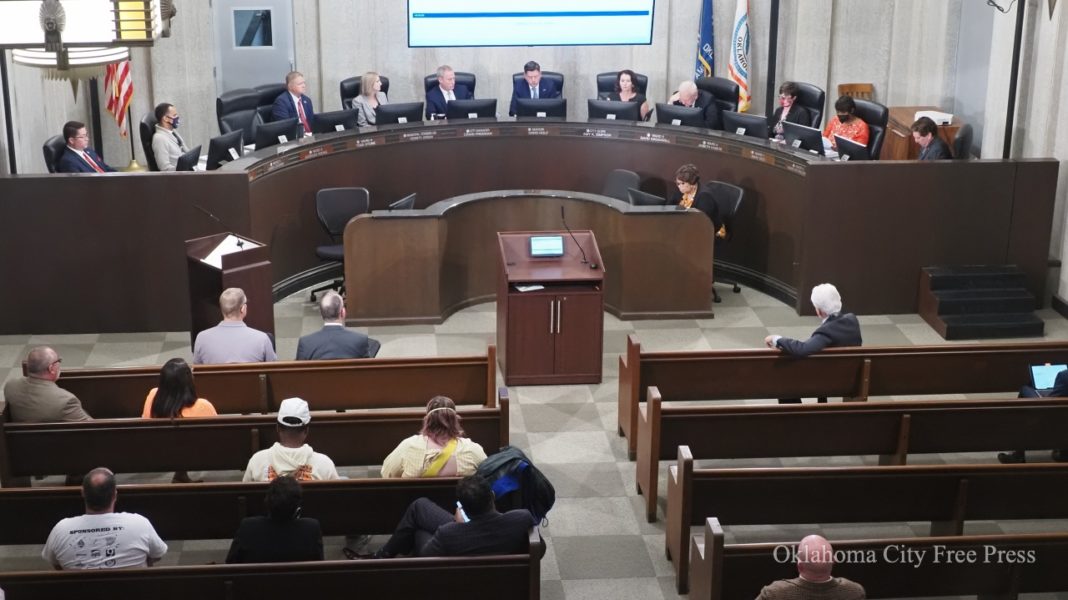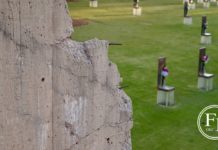Last Updated on August 6, 2023, 2:53 AM | Published: August 2, 2022
OKLAHOMA CITY (Free Press) — On Tuesday, the City Council of Oklahoma City held their regular meeting with a slightly smaller quorum than usually. Ward 1 Councilman Bradley Carter was unable to attend Tuesday’s meeting, as was Mayor David Holt. Vice-Mayor James Cooper presided over the meeting in Holt’s absence.
The Council discussed homelessness services including A Better Way, the work program administered by Mental Health Association Oklahoma. Shortly following that, Council approved allocation of grant funds to several projects addressing youth homelessness.
The Council also spent a considerable amount of time listening to sharply-conflicting testimony from home builders, roofing contractors, and other experts about a building code requirement associated with potential winter weather home damage.

Marty Peercy reports Local government
A Better Way
The Council was asked to approve an allocation of $270.940.58 to continue the A Better Way program for another year through Mental Health Association Oklahoma.
A Better Way is a program based on an idea from Albuquerque, NM. The program offers a day’s work and lunch to people experiencing extreme poverty.
Three days a week, a van sporting the logo of the A Better Way program travels to a few sites to pick up willing participants to travel to public areas such as parks to clean up debris and litter in the area. Midway through the day, participants are given lunch. During lunch, a case manager specific to the local program tells her own story about homelessness and mental health.
Participants in the program are limited to 5 turns on the van.
During the 10 months the program has operated, hundreds of non-repeat participants have taken the day labor job. Many have taken advantage of the case management and/or job assistance services offered to them on their workday.
Ward 5 Councilman David Greenwell had many questions about the participants in the program and traceable data about their lives before participating and what outcomes can be shown after their participation.
Later, Greenwell asked what prevented the program from sending out more vans, since so many people wanted to participate.
Funding does not provide for another van at this time, is the short answer.
The program was started as a pilot with funding from the City and the Inasmuch Foundation. The program is administered by Mental Health Association Oklahoma (MHAOK).
Councilor JoBeth Hamon of Ward 6 recused herself from the discussion and vote, as her full time employer is MHAOK, though her position is not funded by the same revenue source.
The Council approved the money.
Youth homelessness
Council went on to further discuss homelessness with a focus on people under the age of 24 who are experiencing homelessness in our community.
Recently, Oklahoma City projects have been approved for an exclusive grant stream from the federal government to address youth homelessness.

At Tuesday’s meeting, the Council was able to approve grant allocations to several projects.
The U.S. Department of Housing and Urban Development, better known as HUD, selected Oklahoma City as a participant in the exclusive Youth Homelessness Demonstration Program. That program seeks to use HUD funded grants to help communities with nascent youth homelessness programs bring their programs to fruition.
This allows the City to award over $3 million to projects in Oklahoma City that aim at reducing and, in time, eliminating youth homelessness in our community.
The most recent Point in Time count showed that youth homelessness, defined as 24 years of age and under, has increased 30% in the past two years.
The majority of the funding awarded on Tuesday by the City went to Sisu Youth and Hope Community Services.
Sisu, in particular, was given the larger portion of the grant funds. Sisu is currently renovating a building to house a larger shelter, as well as offering a variety of other needed services for young people experiencing homelessness. Free press reported on this previously. The Council voted unanimously to approve the allocations.
Building Codes
In 2019 the City Council approved an amendment to the Building Code modeling the International Building Code. That amendment included something that some say might have been a simple scrivener’s error by somebody above the city level of government.
According to the amendment, new homes must include and ice and water barrier underlayment on roofs that is used to prevent ice damming.
Ice damming is a phenomenon that typically occurs when there is significant snow pack on a roof, with co-occurring thaw and freeze conditions throughout the course of some days. Heat from below may cause the roof-side layer of snow pack to melt, then as it reaches the eaves and temperatures drop outside, the melt freezes and pushes back underneath the shingles. This results in sometimes damaging leaks in the interior of homes.
At Tuesday’s meeting, the Council heard from a long list of experts who each espoused a binary on the issue of ice damming happening in Oklahoma City.
One camp said ice damming doesn’t occur here. One side said it does, and almost every year.
The crux of the debate seemed to rest on the cost of the underlay increasing housing costs versus the cost of damage done by ice to roofs and homes.
Many of the proponents of repealing the portion of code requiring the underlay said that it is recommended for houses built much farther north, and that climate conditions in Oklahoma City do not create sufficient snowfall for ice damming to occur. This means our conditions do not warrant the extra effort and cost, especially when there is a nationwide housing crisis. Those proponents argued that the added cost makes homeownership even more difficult for those needing affordable housing.
The contrary side of the debate cited many years of having to respond to and repair roof damage caused by ice damming. One roofer told a story of coming home during an ice storm to find catastrophic leaks in his home from ice damming damage to his roof. He said it cost tens of thousands of dollars to repair.
Ultimately, the debate lasted for a significant time, nearly an hour. Councilors Hamon and Nice requested more time to research and discuss the issue, as things remained unclear after discussion. Many of the speakers brought supplemental information for the Council. The item was deferred for two weeks so that Councilors could investigate and ask questions before making a decision.
City Council will meet again on August 16 at 8:30 a.m.
Columnist covering local government in Oklahoma City and Oklahoma County from May 2019 through June 2023.










